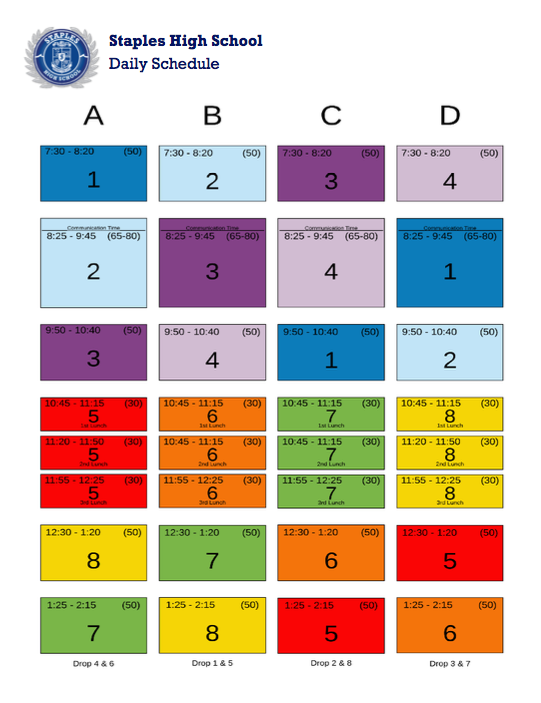Scheduling changes fall short
Image courtesy of Staples High School
The Staples High School daily schedule is made up of eight periods, and each period is assigned a number that coincides with a class on a student’s schedule. With this new change, students will not learn the number of their classes until the end of the summer.
As summer approaches, students’ minds drift to the warmth of the sun and the salty air of the beach. But there is also another prominent topic on the minds of students as June draws closer: class schedules.
My fellow classmates and I all look forward to receiving our class schedules for the next school year. I eagerly anticipate finding out my teachers for the next year, and feel myself growing excited as I learn which friends I will share classes with. But as of this year, Principal James D’Amico has announced that instead of finding out our teachers and periods for each of our class selections, we will simply receive a list of our assigned classes.
I find this confusing. Students are given the power to request classes. While there are always a few instances of scheduling complications, most people get what they ask for. Due to this, there really is no point to simply getting a list of classes, and then having to wait until right before the start of the new school year to finally see our teachers and periods.
In an email to the entire school D’Amico wrote that the school is making the change in order to make sure that the guidance department has the flexibility necessary to make the best master schedule possible, one that caters to the needs of all Staples students. While I do think the extra time allows the guidance department to resolve any conflicts, this reason is not substantial enough to alter a traditional process that has worked well for years.
Another reason this decision by the administration simply does not make sense is because the guidance department claims that they are doing it in order to avoid complications, but in my experience at Staples, most complications come from people deciding to drop or change classes after learning who their teacher is. With this in mind, it seems that guidance is simply delaying the complications, not ending them.
On the guidance department website, it is clear that schedules are expected to be final for every student once they receive it. This is simply unrealistic. Guidance should acknowledge people’s decision to drop after seeing who their teacher is, yet this change completely bars that option. It merely makes it so the issues just come around at the end of the summer instead of the beginning.
On the more personal side of this argument, it is inevitable that this change will result in unhealthy mental health habits for students. On top of the stress of starting a new school year, students will feel the pressure and the impending time crunch of learning about their teachers and classes just days in advance. When schedules were received in June, students are well aware the proximity to summer vacation, making the process occur in a comparatively relaxed atmosphere. The sweaty end-of-summer heat mixed with the overwhelming information of new classes and new teachers can’t be healthy.
Personally, I believe that guidance should not have instituted this change. I understand their need for a solution for the issues that are common with scheduling, but instead of announcing such a drastic change, they should focus on meeting with students individually after they receive their full schedules and addressing any issues that arise.
All in all, this change is disappointing and not logistically sound. On both the grounds of solving scheduling issues and allowing students the satisfaction of having their classes revealed to them, this announcement is not one to applaud.



















































